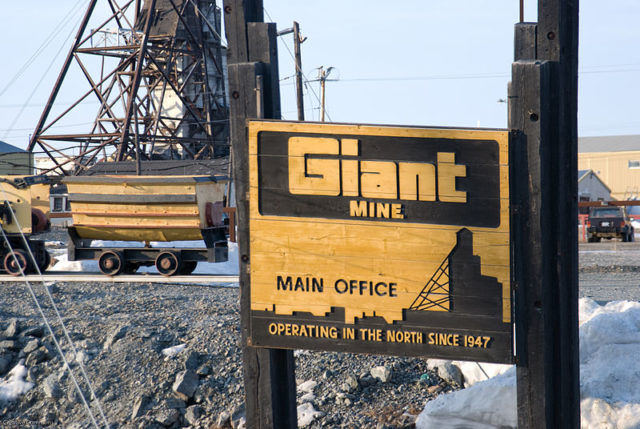Johnny Baker made the discovery and found gold on the Ingraham Trail itself some 5 kilometers to the north of Yellowknife, the only city in the Northwest Territories in Canada.

Finding new, fresh, and previously untouched deposits of gold is always fascinating for all the treasure hunters, gold diggers, miners, and local towns in the area. Truth be told, whole towns were born as soon as people heard about gold deposits in the area. And so Yellowknife appeared in the middle of a great gold boom. The mine that was formed on these lands was named Giant Mine and opened in 1948.

And a successful industry it was. From day one until its final days, the mine produced some 220,000 kilograms of gold. The mine, however, passed through many owners. The first was Falconbridge Ltd., a public company in the industry of mining based in Toronto, though with operations that spread across 18 other different countries.


They owned this mine for 38 years, from 1948 to 1986. Next in the line of owners was Pamour of Australia who operated this mine for a short period from 1986 to 1990. Then followed Royal Oak Mines. They were a mining company that owned a number of properties all around Canada such as the Pamour Mine in Ontario or Colomac Mine in the Northwest Territories of Canada and Royal Oak Mines ran this mine for nine years, starting in 1990 and ending in 1999.

During this period, a terrible thing happened. In 1992, on September 18th, an explosion shook the mine. It happened about 230 meters below ground and killed no less than nine strikebreakers and everyone on the man-car, for at that time the labor unrest was at a full swing.
After the initial investigation, Roger Warren, a miner, was convicted for installing those bombs at the mine. The strike ended in 1993.

One year before the turn of the millennium, the Royal Oak Mines went bankrupt. This same year, DIAND (Department of Indian Affairs and Northern Development) took things into their hands. Then with time, Miramar Corporation took charge of the operations at the mine as well as the maintenance of the mine itself that included control over the water levels as well as the extraction of what was left of the ore. They operated this mine from 1999 to 2004.
But mining for gold is not without its consequences. Once gold is extracted from the arsenopyrite ore, over time a lethal amount of arsenic trioxide is accumulated – a highly toxic dust. Research done in 2006 revealed that this mine had 237,000 tons of this byproduct in its pits.

The mine was officially closed in 2004 but as mentioned before, a harmful amount of arsenic trioxide was left behind, which in itself is an environmental disaster. There were almost 10 square kilometers of land that the Government of Canada had to take care of. An immediate remediation plan had to be developed.

For this purpose, Aboriginal Affairs and Northern Development Canada were consulted and their greatest fear is the 237,000 tons of this deadly dust. Having such a quantity of poison undoubtedly calls for a long-term plan.

And so in 2014, around a billion Canadian dollars was apportioned to the task of freezing this arsenic water-soluble dust in an attempt to decontaminate the area. The technology used in the freezing of ice hockey rinks, will help to keep this underground chambers permanently frozen.


The story of this mine and its days during the labor strike are covered in a CBC film entitled Giant Mine from 1996. The more recent happenings at this mine are depicted in the documentary named Shadow of a Giant, made in 2013 by filmmaker and artist Clark Ferguson.
